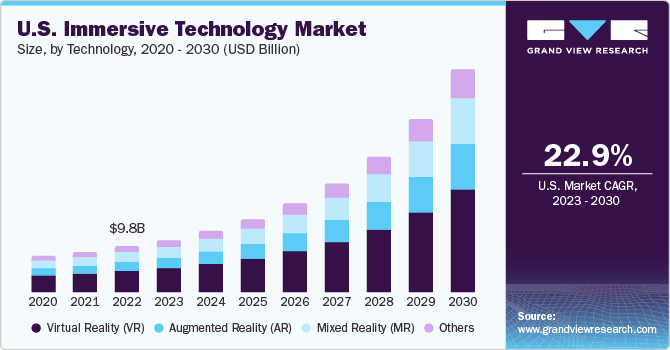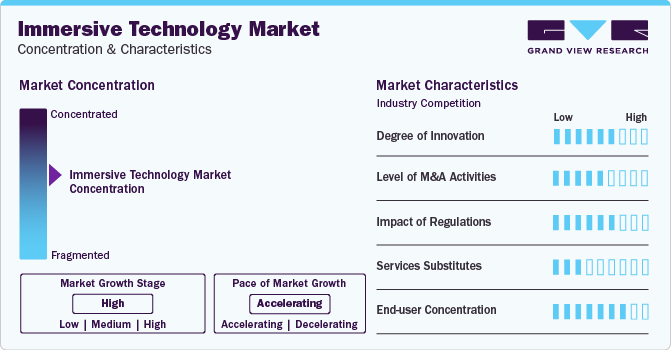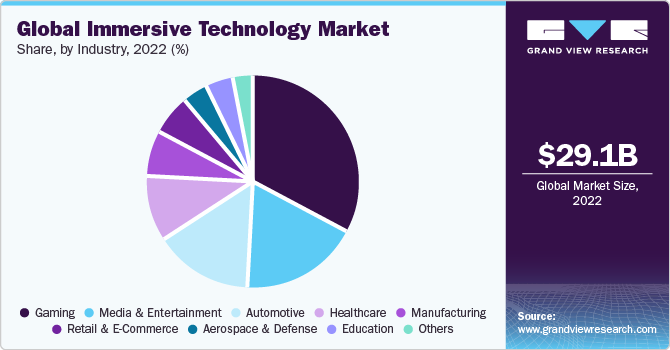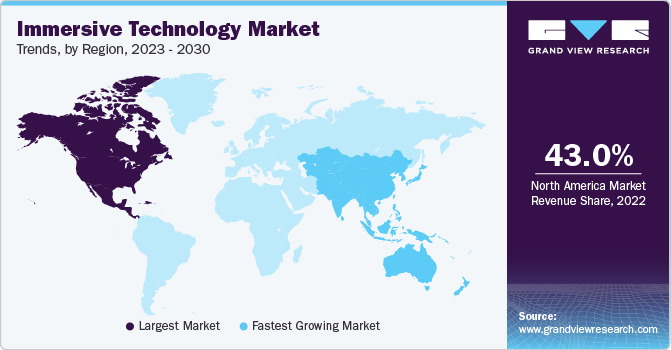- Home
- »
- Next Generation Technologies
- »
-
Immersive Technology Market Size And Share Report, 2030GVR Report cover
![Immersive Technology Market Size, Share & Trends Report]()
Immersive Technology Market Size, Share & Trends Analysis Report By Component (Hardware, Software, Services), By Technology, By Application, By Industry, By Region, And Segment Forecasts, 2023 - 2030
- Report ID: GVR-4-68040-188-9
- Number of Report Pages: 125
- Format: PDF, Horizon Databook
- Historical Range: 2018 - 2021
- Forecast Period: 2023 - 2030
- Industry: Technology
Immersive Technology Market Size & Trends
The global immersive technology market size was valued at USD 29.12 billion in 2022 and is projected to grow at a compound annual growth rate (CAGR) of 25.7% from 2023 to 2030. Immersive technology encompasses a range of technologies that create a highly interactive and engaging environment, blurring the boundaries between the physical and digital domains. These technologies include Augmented Reality (AR), Virtual Reality (VR), Mixed Reality (MR), and Extended Reality (XR).

VR immerses users in a completely artificial environment, while AR superimposes digital information into the real world. MR combines elements of both AR and VR, seamlessly incorporating virtual objects into the user's physical surroundings. The growing adoption of these technologies across diverse sectors, accompanied by developments in software and hardware offerings, is propelling market expansion. The increasing popularity of AR and VR devices, such as handheld AR devices, VR headsets, and smart glasses, is driving industry demand. These devices are becoming more cost-effective and readily available, attracting a broader user base.
The immersive technology sector has seen a swift expansion, propelled by a rising desire for immersive and interactive encounters spanning gaming, entertainment, healthcare, education, and training. Leading players in this industry are persistently striving for innovation to elevate the quality and accessibility of immersive technologies. In order to enhance customer satisfaction, businesses within this sector are deploying such technologies in diverse settings like e-commerce, interactive web applications, immersion marketing, brand engagements, and targeted geographical explorations.
Furthermore, market expansion can be credited to rising investments in immersive technology, increasing adoption of AR/VR technologies in the healthcare domain for training and education, and the emergence of Metaverse and Web 3.0. Additionally, there is a growing need for 3D graphics and real-time 3D expertise, along with an escalating adoption of immersive technology in architecture, construction, and engineering, which is anticipated to generate substantial prospects for this market.
The COVID-19 pandemic additionally hastened the integration of these technologies in different industries, as organizations sought innovative ways to maintain business continuity by encompassing tools for remote collaboration, entertainment platforms, and training solutions. As a result, this industry witnessed increased investments in AR and VR solutions, particularly in areas such as virtual events, remote work, and telemedicine.
The deployment of 5G networks is poised to revolutionize immersive technology by ushering in unprecedented advancements. Increased data transfer speeds and reduced latency offered by 5G connectivity is expected to play a pivotal role in transforming VR, AR, and MR experiences. This next-generation network is set to empower seamless, high-quality streaming of immersive content, allowing users to engage with virtual environments in real-time with minimal lag.
Enhanced connectivity is particularly impactful in applications such as VR gaming, remote collaboration, and AR-enhanced navigation. Furthermore, 5G integration holds the promise of unlocking new possibilities in fields such as healthcare, education, and industry, where immersive technology is increasingly employed for training, simulation, and other innovative solutions. As 5G continues to proliferate, it is anticipated to amplify immersive experiences, fostering a new era of interconnected and dynamic virtual worlds.
Market Concentration & Characteristics
Market growth stage is high, and pace of this market’s growth is accelerating. The market is characterized by a high degree of innovation owing to continuous advancements in hardware, software, and content creation. Rapid technological evolution, coupled with increasing demand across diverse industries, fuels a dynamic environment. This constant push for innovation, driven by emerging applications and improved user experiences, characterizes this market as highly innovative.

The market is also characterized by a high level of merger and acquisition (M&A) activities by leading players. Companies are strategically aligning to harness collaborations, enhance technological capabilities, and broaden market reach. This trend underscores the industry's dynamism, with key players seeking partnerships to capitalize on the growing demand for virtual and augmented reality solutions.
The market is encountering heightened regulatory scrutiny, driven by growing apprehensions surrounding privacy, security, content, and potential societal implications. As a result, governments around the world are actively addressing these concerns, emphasizing the need for comprehensive regulations to ensure responsible development and deployment of immersive technologies in a rapidly evolving digital landscape.
Threat of substitutes is low as there are a limited number of direct substitutes for immersive technology. Traditional forms of entertainment and communication, such as television, cinema, conventional gaming, and holographic technologies, serve as primary substitutes for immersive technologies such as AR and VR. Though these alternatives are not as technologically advanced, they continue to offer established and widely accepted means of engagement as well as affordability & accessibility, which could hinder the widespread adoption of immersive technologies, particularly among cost-sensitive consumers.
End-user concentration is a significant factor in this market’s expansion. This is because there are a number of end-user industries that are driving demand for immersive technology solutions. The concentration of demand in a small number of industries creates opportunities for companies that focus on developing immersive devices and solutions for these industries. However, it also creates challenges for organizations trying to compete in a crowded market.
Component Insights
Based on component, hardware accounted for the largest revenue share of 48.7% in 2022. This high percentage can be attributed to the crucial role that hardware plays in enabling immersive experiences, spanning virtual reality, augmented reality, and mixed reality. Head-mounted displays (HMDs), Gesture Tracking Devices (GTD), Projectors and Display Walls (PDW), sensors, haptic devices, and related peripherals constitute the backbone of immersive technology ecosystems.
Advancements in hardware capabilities, such as increased processing power, higher display resolutions, and improved motion tracking have propelled this market forward. The demand for immersive experiences in gaming, education, healthcare, and corporate settings has fueled sales of sophisticated hardware products. As immersive technologies continue to permeate various industries, the prominence of this segment underscores the pivotal role of robust and innovative hardware solutions in delivering compelling and realistic immersive experiences to users worldwide.
The software segment is expected to register the fastest CAGR during the forecast period. This surge in demand for software solutions can be attributed to the continuous advancements in VR, AR, and MR applications. As hardware capabilities mature, software innovations become a primary driver of enhanced user experiences. Industries such as gaming, healthcare, education, and enterprise are increasingly relying on sophisticated software solutions to unlock the full potential of immersive technology.
From immersive content creation tools to virtual collaboration platforms, software platforms are at the forefront of driving innovation and expanding the immersive ecosystem. Moreover, the adaptability and versatility of immersive software contribute to its widespread adoption, catering to diverse needs across various sectors.
Technology Insights
Virtual Reality (VR) accounted for the largest market revenue share in 2022. VR has found widespread adoption across diverse sectors with its ability to create immersive, computer-generated environments. Gaming and entertainment have witnessed a paradigm shift with VR, offering users an unparalleled level of engagement and sensory experience. Moreover, industries such as healthcare, education, and corporate training have adopted VR for simulations, training modules, and interactive learning environments.
The growth of virtual reality is supported by continuous advancements in hardware, enhanced content creation, and the expanding accessibility of VR devices. As advancements continue to drive hardware and software innovations in the coming years, VR technology is poised for sustained growth, promising new applications and reshaping the way in which individuals interact with digital and physical realms.
Meanwhile, mixed reality (MR) technology is expected to register the fastest CAGR during the forecast period in the immersive technology market. Combining elements from both AR and VR, MR offers users a seamless integration of the digital and physical worlds, providing an unparalleled level of interaction and immersion. The versatility of MR applications spans across diverse sectors, from gaming and entertainment to healthcare, education, and enterprise solutions.
Accelerating adoption of mixed reality solutions is fueled by advancements in hardware, improved spatial mapping technologies, and improvements in content creation capabilities. The ability of MR to overlay digital information onto the real environment while maintaining spatial awareness has positioned it as a powerful tool for training, simulation, and collaborative work environments.
Application Insights
In terms of application, training & learning dominated the market in 2022. Organizations across industries are increasingly leveraging immersive technology to revolutionize training programs. These technologies offer immersive and realistic simulations, enabling trainees to engage in hands-on experiences without real-world consequences. From corporate training modules to educational simulations, the training and learning segment leverages the capacity of immersive technology to enhance retention, engagement, and skill acquisition.
The dynamic and interactive nature of AR and VR has helped transform traditional learning methods by providing a more effective and engaging educational experience. As the demand for innovative and efficient training solutions continues to grow, the training & learning segment is expected to play a pivotal role in shaping this industry’s landscape.
The emergency services segment is projected to witness the highest growth rate through 2030. This growth is propelled by the imperative need for advanced tools that enhance emergency response capabilities. Augmented Reality (AR) and Virtual Reality (VR) technologies are increasingly being adopted to simulate emergency scenarios, providing first responders with realistic training experiences.
AR, in particular, aids in real-time data visualization, enabling emergency personnel to access critical information seamlessly during crisis situations. From simulated disaster response drills to medical emergency simulations, immersive technology empowers emergency service providers to hone their skills, improve decision-making under pressure, and ultimately enhance overall preparedness. Besides, VR applications play a pivotal role in post-trauma therapy for both first responders and individuals affected by emergencies.
Industry Insights
The gaming sector accounted for the largest revenue share in 2022. AR and VR technologies have revolutionized gaming experiences, offering players unprecedented levels of immersion and interactivity. These technologies have elevated gaming to new heights, from realistic simulations to interactive storytelling, attracting a dedicated user base. The demand for immersive gaming experiences has spurred innovations in hardware and content creation, driving competition among organizations. As gaming companies continue to invest in cutting-edge technologies, the immersive gaming sector not only captivates entertainment enthusiasts but also catalyzes broader adoption of this technology across industries.

The healthcare sector is anticipated to witness significant growth in this market. The integration of immersive technologies in healthcare is revolutionizing patient care, medical training, and therapeutic interventions. VR is facilitating realistic surgical simulations, enabling surgeons to enhance their skills in a risk-free environment. Meanwhile, AR is enhancing medical education by overlaying virtual information onto real-world scenarios, fostering a deeper understanding of complex medical concepts.
MR applications are aiding in the visualization of medical data, contributing to more accurate diagnostics and treatment planning. The growing acceptance of telemedicine further amplifies the role of immersive technology in healthcare, providing immersive virtual consultations and remote patient monitoring. As the demand for innovative healthcare solutions intensifies, the sector's adoption of immersive technology is expected to skyrocket, driving the market's overall growth and establishing a paradigm shift in the way healthcare is delivered and experienced.
Regional Insights
North America dominated the market with a revenue share of 43.0% in 2022. This region’s notable market presence can be attributed to proactive government initiatives aimed at fostering the widespread adoption of immersive technology across diverse industries. Government authorities in this region are actively investing in research and development, establishing specialized research institutes and centers, and providing funding for projects related to immersive technologies.

These technologies find application in various sectors, including enhancing gaming experiences, revolutionizing education and training, and catalyzing innovation in healthcare. Several end-use industries are focused on using immersive technology, which is poised to drive regional growth. For instance, in June 2023, Ford Motor Company (U.S.) established a new VR design studio. This studio enables designers, engineers, product developers, and other stakeholders to engage in virtual collaboration from any location, effectively transforming their residences into fully immersive studios that augment productivity and operational efficiency.
Asia Pacific is anticipated to witness significant growth in the immersive technology industry. This growth is attributed to a rising middle class population with an increasing disposable income. Countries such as China, Japan, and South Korea are actively investing and expressing considerable interest in immersive technology. This trend is driven by the expansive consumer base in these countries and a rising demand for cutting-edge digital experiences. China, in particular, has seen a surge in its VR arcade industry, providing immersive gaming experiences and making virtual reality more accessible to a broader audience.
Key Immersive Technology Company Insights
Some key players operating in this market include Microsoft Corporation, HTC Corporation, Samsung Electronics Co., Ltd., and Google LLC (Alphabet Inc.).
-
Microsoft Corporation specializes in virtual reality and mixed reality products, including its signature range of Microsoft HoloLens 2. The mixed reality solution developed by Microsoft Corporation can be used in various sectors, including manufacturing, healthcare, and education. BAE Systems, the Royal Australian Air Force, and the Museum of Relief Maps are some of the major clientele of HoloLens 2.
-
Google LLC is one of the most significant subsidiaries of Alphabet, Inc., offering a wide range of virtual reality products, including VR headsets and software such as Expeditions, Earth VR, Tilt Brush, Cardboard, and Blocks.
-
Barco NV, EON Reality, and Ultraleap Limited (Leap Motion, Inc.) are some notable emerging participants in the market for immersive technologies.
-
EON Reality is a U.S.-based virtual reality and augmented reality software development company. The company provides academic and industrial training solutions based on AR/VR technology, which can be delivered through a wide range of devices, including mobile phones, head-mounted displays, and large screens.
-
Ultraleap Limited is a U.K. based technology company that provides hand-tracking software. In 2019, the company acquired Leap Motion, Inc. and entered the VR market. The company specializes in developing AR and VR hardware, software, and human-computer interfaces. Its leap motion technology is extremely tiny, designed, and developed for consumer electronic products such as VR head-mounted displays.
Key Immersive Technology Companies:
The following are the leading companies in the immersive technology market. These companies collectively hold the largest market share and dictate industry trends. Financials, strategy maps & products of these immersive technology companies are analyzed to map the supply network.
- Barco NV
- EON Reality
- Google LLC (Alphabet Inc.)
- HTC Corporation
- IBM Corporation
- Magic Leap
- Meta
- Microsoft Corporation
- Samsung Electronics Co., Ltd.
- Sony Corporation
- Ultraleap Limited (Leap Motion, Inc.)
- Comp12
Recent Developments
-
In October 2023, EON Reality announced its collaboration with Elixir Traders Limited, a company involved in wholesale activity of household goods, to infuse Extended Reality (XR) technology into different sectors of the U.K. market. This incorporation not only would help improve operating procedures, but also move industries forward into data-driven decisions and immersive interactions
-
In June 2023, Meta launched Meta Quest 3, its next-generation virtual and mixed reality headset that claims to offer stronger performance, higher resolution, innovative Meta Reality technology, and a more comfortable form factor for its users
-
In May 2023, Ultraleap Limited (Leap Motion, Inc.) launched the Leap Motion Controller 2, a second-generation hand-tracking camera that allows users to interact with digital information in 3D using their own hands. The camera is compatible across all platforms and complimentary hardware, such as PCs, holographic displays, VR, and AR
Immersive Technology Market Report Scope
Report Attribute
Details
Market size value in 2023
USD 34.16 billion
Revenue forecast in 2030
USD 169.24 billion
Growth rate
CAGR of 25.7% from 2023 to 2030
Base year for estimation
2022
Historical data
2018 - 2021
Forecast period
2023 - 2030
Quantitative units
Revenue in USD million/billion and CAGR from 2023 to 2030
Report coverage
Revenue forecast, company ranking, competitive landscape, growth factors, and trends
Segments covered
Component, technology, application, industry, region
Regional scope
North America; Europe; Asia Pacific; South America; MEA
Country scope
U.S.; Canada; Mexico; Germany; U.K.; France; Italy; Spain; China; Japan; India; South Korea; Australia; Brazil; UAE; South Africa
Key companies profiled
Barco NV; EON Reality; Google LLC (Alphabet Inc.); HTC Corporation; IBM Corporation; Magic Leap; Meta; Microsoft Corporation; Samsung Electronics Co., Ltd.; Sony Corporation; Ultraleap Limited (Leap Motion, Inc.)
Customization scope
Free report customization (equivalent up to 8 analysts working days) with purchase. Addition or alteration to country, regional & segment scope.
Pricing and purchase options
Avail customized purchase options to meet your exact research needs. Explore purchase options
Global Immersive Technology Market Report Segmentation
This report forecasts revenue growth at the global, regional, and country levels and provides an analysis of the latest industry trends in each of the sub-segments from 2018 to 2030. For this study, Grand View Research has segmented the global immersive technology market report based on component, technology, application, industry, and region.
-
Component Outlook (Revenue, USD Billion, 2018 - 2030)
-
Hardware
-
Head Mounted Devices (HMD)
-
Gesture Tracking Devices (GTD)
-
Projectors & Display Walls (PDW)
-
-
Software
-
Services
-
Professional Services
-
Managed Services
-
-
-
Technology Outlook (Revenue, USD Billion, 2018 - 2030)
-
Virtual Reality (VR)
-
Augmented Reality (AR)
-
Mixed Reality (MR)
-
Others
-
Application Outlook (Revenue, USD Billion, 2018 - 2030)
-
Training & Learning
-
Emergency Services
-
Product Development
-
Sales & Marketing
-
Others
-
-
Industry Outlook (Revenue, USD Billion, 2018 - 2030)
-
Aerospace & Defense
-
Manufacturing
-
Automotive
-
Education
-
Media & Entertainment
-
Gaming
-
Healthcare
-
Retail & E-Commerce
-
Others
-
-
Regional Outlook (Revenue, USD Billion, 2018 - 2030)
-
North America
-
U.S.
-
Canada
-
Mexico
-
-
Europe
-
Germany
-
U.K.
-
France
-
Italy
-
Spain
-
-
Asia Pacific
-
China
-
Japan
-
India
-
South Korea
-
Australia
-
-
South America
-
Brazil
-
-
Middle East and Africa (MEA)
-
UAE
-
South Africa
-
-
Frequently Asked Questions About This Report
b. The global immersive technology market size was estimated at USD 29.12 billion in 2022 and is expected to reach USD 34.16 billion in 2023.
b. The global immersive technology market is expected to grow at a compound annual growth rate of 25.7% from 2023 to 2030 to reach USD 169.24 billion by 2030.
b. North America dominated the immersive technology market with a share of over 42% in 2022. This is attributable to the increased adoption in various industries such as gaming, healthcare, education, and enterprise.
b. Some key players operating in the immersive technology market include Barco NV, Eon Reality, Google LLC (Alphabet Inc.), HTC Corporation, IBM Corporation, Magic Leap, Meta, Microsoft Corporation, Samsung Electronics Co., Ltd., Sony Corporation, Ultraleap Limited (Leap Motion, Inc.).
b. Key factors that are driving the immersive technology market growth include the rising investment in immersive technology, increasing adoption of AR/VR technologies in the healthcare domain for training and education, and the emergence of the Metaverse and Web 3.0.
Share this report with your colleague or friend.
![gvr icn]()
NEED A CUSTOM REPORT?
We can customize every report - free of charge - including purchasing stand-alone sections or country-level reports, as well as offer affordable discounts for start-ups & universities. Contact us now
![Certified Icon]()
We are GDPR and CCPA compliant! Your transaction & personal information is safe and secure. For more details, please read our privacy policy.
We are committed towards customer satisfaction, and quality service.
"The quality of research they have done for us has been excellent."





